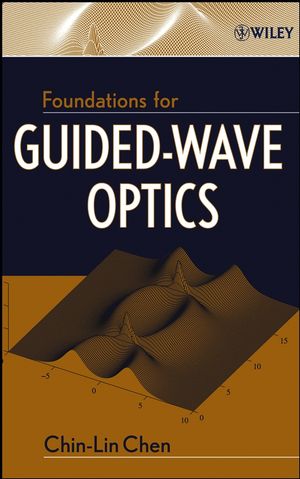Foundations for Guided-Wave OpticsISBN: 978-0-471-75687-3
Hardcover
480 pages
November 2006
 This is a Print-on-Demand title. It will be printed specifically to fill your order. Please allow an additional 10-15 days delivery time. The book is not returnable.
|
||||||
Preface.
1. Brief review of Electromagnetics and Guided Waves.
1.1 Introduction.
1.2 Maxwell's equations.
1.3 Uniform plane waves in isotropic media.
1.4 State of polarization.
1.5 Reflection and refraction by a planar boundary between two dielectric media.
1.5.1. Perpendicular polarization.
1.5.1.1 Reflection and refraction.
1.5.1.2 Total internal reflection.
1.5.2. Parallel polarization.
1.5.2.1 Reflection and refraction.
1.5.2.2 Total internal reflection.
1.6 Guided waves.
1.6.1 TE modes.
1.6.2 TM modes.
1.6.3 Waveguides with constant index regions.
References.
Problems.
List of Figures.
2. Step-index Thin-film Waveguides.
2.1 Introduction.
2.2 Dispersion of step-index thin-film waveguides.
2.2.1 TE modes.
2.2.2 TM modes.
2.3 Generalized parameters.
2.3.1 a, b, c, d and V.
2.3.2 bV diagram.
2.3.3 Cutoff thickness and cutoff frequencies.
2.3.4 Number of guided modes.
2.3.5 Birefringence in thin-film waveguides.
2.4 Fields of step-index thin-film waveguides.
2.4.1 TE modes.
2.4.2 TM modes.
2.5 Cover and substrate modes.
2.6 Time-average power and confinement factors.
2.6.1 Time-average power transported by TE modes.
2.6.2 Confinement factor of TE modes.
2.6.3 Time-average power transported by TM modes.
2.7 Phase and group velocities.
References.
Problems.
List of figures.
3. Graded-index Thin-film waveguides.
3.1 Introduction.
3.2 TE modes guided by linearly graded dielectric waveguides.
3.3 Exponentially graded dielectric waveguides.
3.3.1 TE modes.
3.3.2 TM modes.
3.4 WKB method.
3.4.1 Auxiliary function.
3.4.2 Fields in the R Zone.
3.4.3 Fields in the L Zone.
3.4.4 Fields in the transition zone.
3.4.5 The constants.
3.4.6 The dispersion relation.
3.4.7 An example.
3.5 Hocker and Burns’ numerical method.
3.5.1 TE modes.
3.5.2 TM modes.
3.6 Step-index thin-film waveguides vs. graded-index dielectric waveguides.
References.
Problems.
List of figures.
4. Propagation Loss in Thin-film Waveguides.
4.1 Introduction.
4.2 Complex relative dielectric constant and complex refractive index.
4.3 Propagation loss in step-index waveguides.
4.3.1 Waveguides having weakly absorbing materials.
4.3.2 Metal-clad waveguides.
4.4 Attenuation in thick waveguides with step-index profiles.
4.5 Loss in TM0 mode.
4.6 Metal-clad waveguides with graded index profiles.
References.
Problem.
List of Figures.
5. Three-dimensional Waveguides with Rectangular Boundaries.
5.1 Fields and modes guided by rectangular waveguides.
5.2 Orders of magnitude of fields.
5.2.1 modes.
5.2.2 modes.
5.3 Marcatili's method.
5.3.1 modes.
5.3.1.1 Expressions for Hx.
5.3.1.2 Boundary conditions along horizontal boundaries, y = ±h/2, |x|



